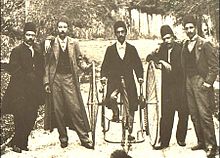Otto Dicycle
The Otto Dicycle was a two-wheeler, the wheels of which were arranged side by side and were moved via cranks. Edouard Carl Friedrich Otto (1841-1905), a German-English inventor from Peckham ( Surrey ), received an English patent on March 31, 1879 and the US patent on July 5, 1881 for the strange vehicle. The Otto Dicycle was the best known and most widespread of all dicycles at that time. Birmingham Small Arms Company manufactured about 1000 pieces of these devices from 1879, which also came onto the market in Germany. Thomas Stevens reports that even the Shah of Persia, Nāser ad-Din Shah , introduced a tricycle through an Englishman. The design concept was the safety compared to the penny farthing of the time : “You could jump off and fall at any speed, and you could turn on the spot.” Ladies and gentlemen could learn the “Otto” without the slightest risk, with more attention going downhill the "Ottoist" was asked to be on a level route. The vehicle was driven by cranks and a double belt drive, the wheels could be steered and braked separately using two rotary handles. A tail wheel made it impossible to tip over backwards.
Web links
literature
- Max JB Rauck, Gerd Volke, Felix R. Paturi: By bike through two centuries. The bicycle and its history. 4th edition. AT Verlag, Aarau u. a. 1988, ISBN 3-85502-038-8 .
- Thomas Stevens : 20,000 miles around the world on a penny farthing. 1884-1886 . Thienemann Edition Erdmann, Stuttgart 1984. ISBN 3-522-60670-1 .
- John Woodeford: The Story of the Bicycle. Routledge & Kegan, London 1970, ISBN 0-7100-6816-6 .

